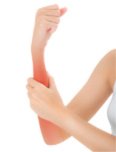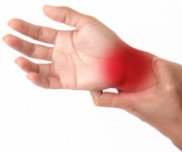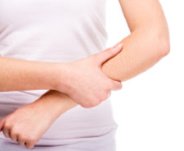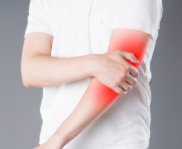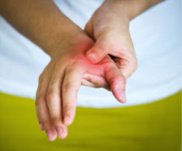Carpal Tunnel Syndrome Anatomy
Carpal Tunnel Syndrome anatomy has several components that can directly affect the development of Carpal Tunnel Syndrome. Learning about each of them can help you determine what the source of your injury is and what you can best do to heal as quickly as possible.
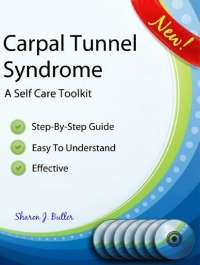
Click HERE to Learn More
The Median Nerve: The Most Important Part of Carpal Tunnel Syndrome Anatomy
The most essential component of Carpal Tunnel Syndrome anatomy is the median nerve. This important nerve begins as part of the brachial plexus of nerves. It originates at the neck, passes under the collarbone and across the front of the shoulder.
At the front of the shoulder, the brachial plexus divides forming the three separate nerves: median, ulnar and radial. From that point on, the median nerve is considered a separate entity in the anatomy of the arm.
The median nerve pathway continues down the arm, passing through a seam of fascia between the biceps and triceps muscles on the inside of the upper arm. It then travels through the elbow area, and down the inside of the forearm into the wrist and hand. Ultimately, the median nerve terminates in the thumb, index and middle fingers.
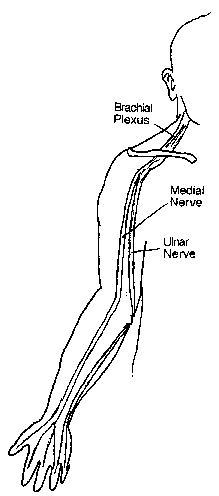
The median nerve is responsible for bringing feeling to the palm side of the hand and wrist, the thumb, the index and middle fingers and sometimes to part of the ring finger.
The Wrist Bones and Carpal Tunnel Syndrome
The wrist bones are the second most important part of Carpal Tunnel Syndrome anatomy.
The wrist is made up of several small carpal bones which form an arch of bone, the open part of the arch on the palm side of the hand. Passing through this arch, known as the carpal tunnel, are several tendons, blood vessels and the median nerve.
Typically, when the space in this arch is compressed or reduced in volume for any reason, unusual pressure is placed on the tendons and median nerve that occupy this space and the nerve becomes irritated. This causes symptoms typical of Carpal Tunnel Syndrome like numbness, tingling and weakness of the thumb and first two fingers.
The Flexor Muscles and Carpal Tunnel Syndrome
The flexor muscles are also major players in Carpal Tunnel Syndrome anatomy. The flexor muscles are located on the palm side of the forearm. The flexor muscles, when contracted, cause the fingers to curl, or to close around an object. In the case of computer operators, the flexor muscles are used to curve the fingers so they can strike computer keys.
It is the tendons of the flexor muscles that pass through the carpal tunnel of the wrist. They can become irritated, probably as a result of repeated contraction of the flexor muscles. One result is that the protective synovial sheaths surrounding the tendons can become swollen causing a narrowing of the space in the carpal tunnel.
The flexor muscles are also prone to developing adhesions, or stuck places, between them as they lie in their nearly parallel positions in the forearm. When adhesions occur, the median nerve can become snagged as it passes through the area.
As the adhesions develop further, they create a drag on the normal ability of the median nerve to slide between the muscles as they contract and relax. Eventually, the adhesions lead to irritation of the nerve and symptoms develop as a result.
Synovial Sheaths Protecting the Median Nerve
Tendons are strong and inelastic straps that connect the muscle to bone. Even though tendons are incredibly strong, they require protection from constant rubbing as they pass over bones at a joint. Sheaths filled with synovial fluid surround the tendons as they cross the wrist, protecting the tendons of the flexor muscles as they contract and relax.
The protective synovial sheaths are normally fluid filled but can also become dehydrated, causing the tendons to become irritated as they rub back and forth through the dried out sheaths. This irritation leads to swelling of the area as the body attempts to protect itself from excessive wear to the important tendons.
As swelling from constant wear and tear increases, it narrows the available space in the carpal tunnel, ultimately squeezing all the contents of the tunnel, including the median nerve.
Eventually, the median nerve becomes so irritated that the nerve starts to send out inappropriate and uncomfortable signals like tingling and numbness, leading to many of the symptoms of Carpal Tunnel Syndrome. This is a good reason to drink plenty of water . Having enough fluid in your system will help prevent this dehydrating effect.
To learn more about Carpal Tunnel Syndrome, visit the following sections:
Carpal Tunnel Syndrome Symptoms
Carpal Tunnel Syndrome Self Care
How To Correct Problems With Your Carpal Tunnel Syndrome Anatomy
Carpal Tunnel Syndrome requires careful and gentle stretching of just the right tissue, in the right order, to successfully correct the causes of your symptoms. You can learn everything you need to know, including the most recommended stretches and complete instruction in the program I have designed for you. Click here for more information.
Click the block below that most closely matches your injury for more information and to find the Toolkit we offer to help you in your recovery.

